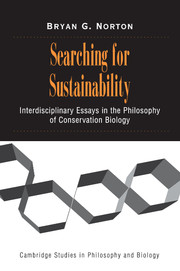Book contents
- Frontmatter
- Contents
- Searching for Sustainability
- General Introduction: An Interdisciplinary Experiment
- I PRAGMATISM AS AN ENVIRONMENTAL PHILOSOPHY
- II SCIENCE, POLICY, AND POLICY SCIENCE
- 6 What Is a Conservation Biologist?
- 7 Biological Resources and Endangered Species: History, Values, and Policy
- 8 Leopold as Practical Moralist and Pragmatic Policy Analyst
- 9 Improving Ecological Communication: The Role of Ecologists in Environmental Policy Formation
- III ECONOMICS AND ENVIRONMENTAL SUSTAINABILITY
- IV SCALING SUSTAINABILITY: ECOLOGY AS IF HUMANS MATTERED
- V SOME ELEMENTS OF A PHILOSOPHY OF SUSTAINABLE LIVING
- VI VALUING SUSTAINABILITY: TOWARD A MORE COMPREHENSIVE APPROACH TO ENVIRONMENTAL EVALUATION
- Index
- References
9 - Improving Ecological Communication: The Role of Ecologists in Environmental Policy Formation
Published online by Cambridge University Press: 21 January 2010
- Frontmatter
- Contents
- Searching for Sustainability
- General Introduction: An Interdisciplinary Experiment
- I PRAGMATISM AS AN ENVIRONMENTAL PHILOSOPHY
- II SCIENCE, POLICY, AND POLICY SCIENCE
- 6 What Is a Conservation Biologist?
- 7 Biological Resources and Endangered Species: History, Values, and Policy
- 8 Leopold as Practical Moralist and Pragmatic Policy Analyst
- 9 Improving Ecological Communication: The Role of Ecologists in Environmental Policy Formation
- III ECONOMICS AND ENVIRONMENTAL SUSTAINABILITY
- IV SCALING SUSTAINABILITY: ECOLOGY AS IF HUMANS MATTERED
- V SOME ELEMENTS OF A PHILOSOPHY OF SUSTAINABLE LIVING
- VI VALUING SUSTAINABILITY: TOWARD A MORE COMPREHENSIVE APPROACH TO ENVIRONMENTAL EVALUATION
- Index
- References
Summary
INTRODUCTION: DO WE NEED NEW TERMINOLOGY FOR ECOLOGICAL COMMUNICATION?
I recently [1995] attended an excellent workshop on “Communicating with the Public on Ecological Issues”; the subject of the workshop was to discuss how well scientific ecologists, agencies, and the public communicate regarding ecological matters and how to improve these communication processes. Generally, participants were critical of the current levels of communication, but many positive and constructive ideas were contributed by break-out groups. One group was charged to discuss “Characteristics of Ecological Issues Affecting the Communication Process” and reported back with a list of caveats and recommendations. The first of these (as delivered by group leader Lawrence Slobodkin) was that we do not need any new scientific terms, such as “ecological health” or “ecological integrity.” “Everything that needs to be said to the public,” Slobodkin argued, “can be said in the existing terminology of ecological science.” Since I know Larry enjoys a good philosophical argument, and I hope he will agree that the subject is of general interest, I here set out to provide a careful criticism of that recommendation. In the process, I hope also to provide, more positively, a brief glimpse of a somewhat different way of looking at the relationship between description and evaluation, and of a different way of relating social and natural science in policy process.
- Type
- Chapter
- Information
- Searching for SustainabilityInterdisciplinary Essays in the Philosophy of Conservation Biology, pp. 136 - 164Publisher: Cambridge University PressPrint publication year: 2002



